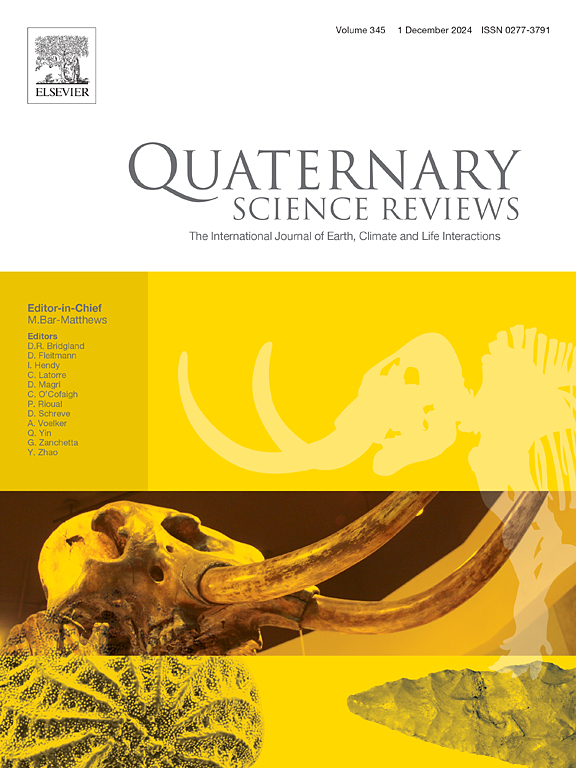Vegetation and climate changes during the Middle to Upper Palaeolithic transition in the southwestern Mediterranean: What happened to the last Neanderthals during Heinrich stadial 4?
IF 3.3
1区 地球科学
Q1 GEOGRAPHY, PHYSICAL
引用次数: 0
Abstract
During the last glacial period, and particularly Marine Isotope Stage 3 (MIS 3, dated 60–27 ka), various abrupt and arid climate episodes impacted the northern hemisphere. These are known as Heinrich Stadials and are linked with major iceberg discharged in the North Atlantic. Heinrich Stadial 4 (HS4), one of the strongest of these events occurring around 39 ka BP, has raised numerous debates regarding its potential impact on the Middle to Upper Palaeolithic transition (MUPT) and Neanderthal extinction, especially in the Iberian Peninsula where late persistence of Neanderthals has been claimed beyond 40 ka BP. Although palynological studies from the Iberian margins have previously highlighted vegetation changes during this period, these have generally been of low resolution and thus, the environmental conditions during HS4 and the possible impact of this event on the last Neandertal populations are still poorly understood.
This study uses the marine core from Ocean Drilling Program (ODP) Site 976, located in the Alboran Sea, to provide new ultra-high-resolution analyses for the interval between 41 and 34 ka BP, including the Greenland Stadial 9 (GS9)/HS4 and the Greenland Interstadial 8 (GI8). The aim is to reconstruct vegetation and climate changes in southern Mediterranean with a resolution never achieved before and to discuss human occupation in the frame of these changes. Vegetation, climate changes and human occupation are discussed on the basis of 1) pollen analysis, 2) quantitative climate reconstructions based on a multi-method approach, and 3) maps of human occupation based on a synthesis of archaeological sites for western Mediterranean Europe in the 42–34 ka BP time interval. Results show a fast spread at centennial scale of steppe and semi-desert vegetation, with a typical three-phased pattern for the GS9 (HS4). This pattern is compatible with the results of various records from Greenland, southwestern Europe and Brazil. The description of these phases with an unpreceded resolution for the SW Mediterranean region supports the connection between the hydroclimatic changes in Greenland and lower latitudes, while the transition to the following GI8 climate amelioration displays a major vegetation instability that mimics the pattern of the last deglaciation at sub-millennial scale. The climate reconstruction shows cold conditions during HS4 and enhanced aridity mostly linked to the winter rainfall deficit caused by the abrupt disturbance of the Mediterranean seasonal regime of precipitations. The regional comparison with available palynological and paleoclimatic records from the western Mediterranean and the Atlantic sheds light on the spatial expression of the arid event, highlighting a south-westward trend in aridification in the Iberian Peninsula. The Alboran Sea appears as a critical area at the interface of the Atlantic and Mediterranean influences, recording the particular expression of fast climate oscillations in the westernmost part of the Mediterranean. The possible impact of such extreme climate event on the MUPT is discussed based on an updated dataset of archaeological sites and dates for western Mediterranean Europe in the 42–34 ka BP time interval. Maps of human occupation show that Neanderthals may have undergone population contraction during the arid conditions of HS4, but it is still challenging to place the MUPT in a sub-millennial chronological framework due to the uncertainty and limitations of archaeological data.
地中海西南部旧石器时代中晚期过渡时期的植被和气候变化:海因里希时期最后一批尼安德特人发生了什么?
在末次冰期,特别是海洋同位素阶段3 (MIS 3,年代60 - 27ka),各种突变和干旱气候事件影响了北半球。这些被称为海因里希冰川,与北大西洋的主要冰山有关。Heinrich Stadial 4 (HS4)是这些事件中最强烈的事件之一,发生在39 ka BP左右,引起了许多关于其对中晚期旧石器时代过渡(MUPT)和尼安德特人灭绝的潜在影响的争论,特别是在伊比利亚半岛,尼安德特人的后期持续时间超过40 ka BP。尽管来自伊比利亚边缘的孢粉学研究之前已经强调了这一时期的植被变化,但这些研究通常分辨率较低,因此,HS4期间的环境条件以及这一事件对最后的尼安德特人种群的可能影响仍然知之甚少。本研究使用了位于Alboran海的ODP 976站点的海洋岩心,对41 ~ 34 ka BP的地层进行了新的超高分辨率分析,包括Greenland Stadial 9 (GS9)/HS4和Greenland Interstadial 8 (GI8)。目的是重建地中海南部的植被和气候变化,并在这些变化的框架内讨论人类活动。基于花粉分析、基于多方法的定量气候重建和基于综合考古遗址的42-34 ka BP的西地中海地区人类活动图,对植被、气候变化和人类活动进行了讨论。结果表明,在百年尺度上,GS9 (HS4)的草原和半荒漠植被扩展速度较快,呈典型的三阶段分布模式。这种模式与格陵兰岛、欧洲西南部和巴西的各种记录的结果是一致的。以前所未有的分辨率对地中海西南地区这些阶段的描述支持了格陵兰岛水文气候变化与低纬度地区之间的联系,而向随后的GI8气候改善的过渡显示了一个主要的植被不稳定,模仿了次千年尺度上的最后一次冰川消融模式。气候重建表明,HS4期间的寒冷条件和干旱加剧主要与地中海季节降水突变引起的冬季降水亏缺有关。通过与西地中海和大西洋现有孢粉学和古气候记录的区域比较,揭示了干旱事件的空间表现,突出了伊比利亚半岛的西南干旱化趋势。Alboran海是大西洋和地中海影响界面的关键区域,记录了地中海最西端快速气候振荡的特殊表现。基于一个更新的42-34 ka BP时间间隔的西地中海考古遗址和日期数据集,讨论了这种极端气候事件对MUPT的可能影响。人类活动地图显示,在HS4的干旱条件下,尼安德特人可能经历了人口收缩,但由于考古数据的不确定性和局限性,将MUPT置于低于千年的时间框架中仍然具有挑战性。
本文章由计算机程序翻译,如有差异,请以英文原文为准。
求助全文
约1分钟内获得全文
求助全文
来源期刊

Quaternary Science Reviews
地学-地球科学综合
CiteScore
7.50
自引率
15.00%
发文量
388
审稿时长
3 months
期刊介绍:
Quaternary Science Reviews caters for all aspects of Quaternary science, and includes, for example, geology, geomorphology, geography, archaeology, soil science, palaeobotany, palaeontology, palaeoclimatology and the full range of applicable dating methods. The dividing line between what constitutes the review paper and one which contains new original data is not easy to establish, so QSR also publishes papers with new data especially if these perform a review function. All the Quaternary sciences are changing rapidly and subject to re-evaluation as the pace of discovery quickens; thus the diverse but comprehensive role of Quaternary Science Reviews keeps readers abreast of the wider issues relating to new developments in the field.
 求助内容:
求助内容: 应助结果提醒方式:
应助结果提醒方式:


